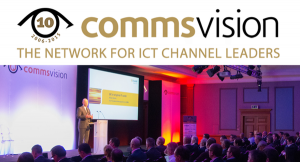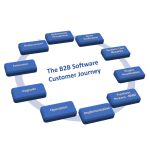An Introduction to The Anatomy of The Software Industry
 Consumption of tele and data communication has exploded across all industries and the prices for basic services continue to decline. Meanwhile, pure play software innovators are offering OTT (over-the-top) value added services. So how do the telco vendors and their channel partners get a share of a market that grows in value rather than be shackled by obsolescence, commoditisation and price competition?
Consumption of tele and data communication has exploded across all industries and the prices for basic services continue to decline. Meanwhile, pure play software innovators are offering OTT (over-the-top) value added services. So how do the telco vendors and their channel partners get a share of a market that grows in value rather than be shackled by obsolescence, commoditisation and price competition?
In my keynote presentation at the CommsVision 2016 conference I give some of the answers to what it takes to start and run a successful software company.
Transcript
In the course of the next minutes I’m going to give you a brief introduction to the anatomy of the software industry. Now why would you be interested in hearing about the software industry?
I guess there are three reasons:
- The first reason is that the software industry is the home of the fastest growing companies in the world.
- The second reason is that the software industry is the home of the highest gross and net profit margins in the world and
- The third reason is that the software industry is achieving these glamorous results by stealing your revenue and your profit.
So if you can’t beat them could you join them?
And to answer that question I need to share with you my experience with the telecommunications industry.
I’m by no means a telecommunication industry experts, but as anybody else in the world I’m exposed to it and have been for a number of years and want to share that with you here in the beginning.
So we need to go back in history. We need to go back to when I was a little boy. And I remember that my grandmother put a coin on the phone when she went out. When she came back in and the coin was on the table she knew that somebody had called.
She would go on brew herself a cup of coffee and then she started calling systematically to family and friends to find out we were called and what it was about.
My grandparents had Sundby 267X. So you’d call the exchange and you ask for 267X. The X was indicating that my grandparents were sharing the line with somebody else. They were sharing the line with the family on the first floor- In the fifties telecommunication was a serious matter.
Ten years forward I spent my summer holiday camping in Italy with my parents. That was also the year that I turned 16 and as we were listening to maybe even dancing to a Whiter Shade of Pale by Procol Harum I was introduced to an Italian girl with brown eyes and jet-black hair. You might be able to see who’s who of this picture. That certainly left a big impression on a blonde scandinavian boy of Viking origin. So I was definitely determined to stay in touch. Upon our return to Denmark my father made it clear to me that there was no way that I could stay in touch with my new Italian acquaintance through
long-distance phone calls. That was prohibitively expensive.
Telecommunication was a serious matter.
So what did we do?
For at least for a couple of years we wrote letters to each other. Now in the sixties the postal service was still making good money.
Fast forward to 1987 that was the year that I got my first cellular phone. It was an Ericsson NMT. It was installed in my car. Well, the radio unit was actually installed in the trunk and the headset was installed between the seats. So you drive and you talk while you’re on the road.
I was with my first startup in those days – it was a software company – and I was a really on the road all the time and I remember that that mobile phone was a real productivity booster. I could call my wife and say that I would be home late, but it was also genuinely a productivity booster for business purposes.
But this little thing on the roof was definitely not unimportant either. It told a very important message about the owner off the car- In the eighties telecommunication was still a very serious business – something that you paid a lot of attention to.
I worked for a couple of years in the US and I had a cellular subscription out of Miami and I was the proud owner of one of these clam shell phones. I didn’t use it very much because the base call charge inbound and outbound plus whatever charges would be added from the conversation was one dollar. If people called me I promised to ll call you back as soon as I could. As soon as I came back to the hotel or found a phone booth I would use a trunk service, which was provided by I believe a AT&T, where I would dial an access number. I had a little book with access numbers for each country in the world and for all the states i The US and i would call that access number and then a hashtag and a star and then the number I needed to access. All to avoid the long distance phone charges. Now that is the first time I remember starting to tweak the telecommunication system with the assistance of AT&T – that I never really understood – but we tweaked the system to save costs on telecommunication.
I moved to Germany in 1998 and I was among the first to switch from ISDN to ADSL. That was a pivotal point for my business and I believe also for the telecommunication business. Not only was it an amazing improvement in Internet connectivity and the experience of browsing the Internet. It definitely also accelerated the proliferation of the Internet and change my industry and I i believe it also change your industry and maybe it happened to change every industry.
So when my daughter became a teenager in the beginning of this century and met somebody on a summer holiday, telecommunication was certainly no longer an issue on the family dinner agenda anymore. Telecommunication was still important, but it was but it was not something that we
paid a lot of attention to. It was like water from the tap or electricity from the grid it was there in abundance and a very low price.
Family life sudden became much much easier and we didn’t get as much noise from the back seat anymore.
When I started my current company was at TKB Consult in 2007 I cannot recall that we spend a single minute worrying about are paying attention to telecommunication. I spent some time figuring out which headset I should buy, but apart from that telecommunication was not something we paid any attention to.
So what does a company like mine, which is a small consulting company operating worldwide, what do we worry about what do we pay attention to?
Preparing for this conference I took an inventory of our suppliers and here they are. In this block here we have our professional services providers. Those are the hands and the heads of people who help us run our business. And in this block here we have our software providers. Actually not all of them. Some of them would pay for using and some of them somebody else is sponsoring so that we can use them free of charge.
Now the professional services is consuming 71 percent of our operational expenses and the software vendors are consuming 21 percent of our operational expenses. Over here in the corner we have two Telecommunication vendors and they consume less than 2 percent of our operational expenses. I could easily switch Fullrate for another broadband provider tomorrow. I couldn’t switch 3 that easily because they provide free roaming in most of the countries where I travel and that’s very valuable to me.
When I looked at this picture it dawned on me that behind all the services that are really important to us professional services and also software services this a lot of telecommunication going on.
Of our professional services providers the Bureau of small projects is located in Los Angeles and they take care of our website. Kompot Design is designing all our publications – we run our publishing company – so they do all the design and illustrations. They are located in Tallinn Estonia. Red Box is providing virtual personal assistance services to us. They do all our administration work and are located in Portugal. To coordinate the projects with people in Los Angeles, in Estonia, in Copenhagen and in Portugal, we use a web based project collaboration and management platform called Jive. Oour files are shared through Dropbox. We do a lot of animation videos for clients and to upload those to to YouTube or Vimeo it goes directly from Dropbox to the service. It doesn’t even go through our computers. When we need to talk we use skype. When I need to talk to my clients we use Skype, Google Hangout, WebEx, Go-to-Meeting or some other service. We don’t use the telephone.
So would it be possible for the telecommunication industry to take some of that?
Well, so far as I can see from the logos here none of these services are provided by a telco company! It’s all – I believe you call OTT over-the-top services – and they’re provided by somebody else.
When I look at the telecommunication industry from my perspective it seems that the only answers you have are two strategic approaches:
- Either you think: We need to keep Hans Peter Bech company as a customer so we’ll do more packaged services that we can offer to him at a lower price with increasing performance and quality. That’s the volume approach where you need to package your services so that you can compete on price. I’m absolutely delighted that you do that.
- But then there’s the another approach where you don’t want to do business with Hans Peter Bech, because he doesn’t have a need for very sophisticated telecommunication services. Instead you take a customized approach to people that have massive call centers who have the needs for IT infrastructure with with a high-bandwidth communication lines. Those are the people you choose to serve.
It just seems to me that both approaches are very exposed to commoditization, they are exposed to hyper-competition and they’re facing eroding margins. It’s a race to the bottom, so could you possibly grab some of that fast growth in the software industry? Could you grab some of that very attractive margin that they take from you? Because what they offer me includes the telecommunication services that you used to provide and charge for.
Well let me give you an introduction to the software industry and you can judge for yourself.
Marc Andreessen was the founder of the first commercial browser company Netscape back in the nineties. Today is he is – I believe – a very successful venture capitalist with A16Z in the US.
He wrote an article in the Wall Street Journal in August 2011 with the headline Why Software is Eating The World. He explains that software is creeping into everything. If you are a car manufacturer then a major part of your product will be software in the future. If you produce TV sets the major part will be software. All industries will be affected by software. If not in the product then in your internal business processes either facing your supply chain or your customers. He also claims that it’s the fastest growing industry in its own rights because there are lots of new business model based on software.
I believe he is right. It is the fastest growing industry and it’s also the most profitable industry in the world. It’s definitely a place that you should look to be.
One of the other things that sustain that claim is that if you look through the top hundred most valuable brands in the world 17 of those are technology/software companies. Only 3 are telecommunication companies.
If you look at the top 30 most valuable brands in the world – they are listed here – already of 11 of those are software/technology companies.
I would say that the software industry is open to everybody and the good news is that it is probably the industry with the lowest barriers of entry of any industry. It only takes a couple of bright people and a couple of computers and you have a software product. You may not have a software business, but you have a software product. If you want to build a sustainable software business there are few idiosyncrasies that you need to be familiar with and I will share those with you just now.
To do that I need to introduce you to a simple concept this is called a business model. The business model can be used to describe any business in the world.
If you want to start a software business you obviously need to come up with a value proposition that is more attractive to the customers that you want to serve than the competitive alternatives.
Now you I assure you think “Hans Peter Bech that’s not rocket science. It goes for any industry that you need to come up with something better than what is already available!”
But there are couple of conditions in the software industry that makes it very difficult to nail this relationship between the value of your what you offer and the needs that the customers have. There are two conditions that you have to be able to deal with and the first one is that:
- Software is invisible. You can’t walk around a piece of software and say “Oh that’s what it’s like. So that’s what it does ok!” Maybe you can do that with an app that tells you the weather forecast for the next five days, but if we’re talking about business software it’s actually very difficult to explain and understand what it does. Now if I say ASAP you immediately say business software, but that’s only because you already know the brand. If you go into the website of any software company that you don’t know (which may be difficult) but if you go into some lesser no brands you will see how difficult it is for these companies to explain what they do and for you to understand what they do. So
software is invisible and that makes it very difficult to communicate what it is that it does - the value of software is very situational. This illustration is of a party and this party. The DJ is the same every night, he plays the same music in the same sequence every night, but the party is
never the same. Because it depends on the crowd present. The same is the case in the software industry. You may have two pieces of the same software installed in two separate companies that are comparable. In the one company it will produce wonderful value and it will increase the productivity. In the other company they’ll meet in court to sort out the problems related to the fact that this software didn’t work. Why is that so? It is so because to deliver value from business software the customer needs to adapt his business processes to the software and he needs to train and motivate his people to use the software as intended. Now obviously the software vendors will provide services helping the customer to achieve that value, but it doesn’t come automatically from the product.
These two conditions that software is invisible and the value is very situational exposes the software
industry to a challenge that is called the law of diffusion of innovation. It was coined by a professor Rodgers in the fifties. Rodgers was a Professor in agriculture technology, but what it says is that if you have something new, which is invisible and where the value is situational only the
technology enthusiasts and the visionaries in the market will talk to you. That’s what we call the early market. The mainstream market a scared to death by anything that is new. They are scared to death by something that can go wrong, that may damage their company, that may hurt their career, so they’re not going to listen to you. They will wait until your technology has been commoditized to a certain degree and until a market leader emerges. Then they can pick a supplier without too much risk.
The challenges that the early market is only accounting for 16 percent of the total market and that the mainstream market is accounting for the remaining 84%. Why is that a challenge?
It’s a challenge because if you want to make it in software you need to get past twenty percent market share. You you need to become a recognized brand because then people will come to you. Not based on your product, but based on your reputation. And when they do they do that, then your average customer acquisition cost will fall. On each and every copy that you sell of your software the marginal cost of producing that is zero. So the revenue will drop directly down on your bottom line. You can invest in marketing and sales. You can invest in improving the product and you are now engulfed in the tornado and on your way to market leadership.
If you have ambitions of becoming a software company then you have to understand that the market leaders take it all. You either go for market leadership or you go away.
That’s the nature law in the software industry.
Now which market are we talking about? We’re in the UK – I believe Scotland’s a part of the UK – of the British Isles at least right (you never know these days)?.
If we go back to look at our vendors, how many of these companies are Danish? Well you wouldn’t know, but actually only two! Monero down here who is our auditor and it’s Fullrate who’s our broadband provider. The rest of the companies are foreign companies. Are there then no Danish software companies providing these kind of services? There were, but some of them have actually been a acquired by the big global players. Skype has roots in in Denmark. was developed in Estonia. You may say that the idea was coined in Denmark. Microsoft swallowed up some of our local ERP providers.
The software industry is global.
Now obviously Denmark is a very small market – it’s just about 0.3 percent% of global demand, but the UK only represents about less than 3 percent of world demand so it is not enough to sustain a software industry on its own.
Are there no local players in the software industry? Because I know that most of you are actually primarily operating in the UK. Is the software industry not for you?
To answer that question we need to take look at the business model again and we need to look at these two building blocks: The channels and the customer relationships.
The channel is responsible for finding new customers, nurture the relationship, mature the relationship, activate the need for your product, developed the business opportunity, and win the deal. The customer relationship building block is responsible for making the customer happy, making him stay with you and expand the customer relationship
How do we do that in the software industry? I have a few examples that I will share with you showing how we do that.
Basecamp
This is Basecamp. They provide a web-based project collaboration and communication
management platform for small and medium-sized projects You don’t put a man on the moon with Basecamp and you don’t dig a tunnel under the channel with Basecamp, but I’m absolutely sure that both NASA and the organization behind the channel will use Basecamp.
They started in 2004 and today they have two million customers spread around the globe. Their solution is available in languages including Russian, French, Chinese, German all the main languages. How do you become a customer Basecamp. Well, you hear about them or you go to their website. They don’t do any outbound marketing or sales at all. You either hear about them or you find them. You go to their website, you sign up for a 30-day free trial. If you like it you convert to a paying customer. If you don’t like it anymore, you download all your data and you unsubscribe. Making a commitment for Basecamp is a very very small commitment, so there’s not a very big risk associated with it.
What does it take to run a company like Basecamp? It takes 50 people. Five of them are located in the one office that Basecamp has and that’s in downtown Chicago. The rest are spread all over the globe. Not that Basecamp has operations all over the world. These people are working out of their homes serving customers across the globe. Now Basecamp could run their business from the moon if only the internet connection was strong enough – maybe that’s something you could fix?
SimCorp
This is SimCorp. They provide software for the financial management industry so if you’re running a pension fund with a lot of money you go to people like SimCorp. They started out with this particular business in 1995 and today they have 170+ customers around the world. To manage those 170+ customers they have 1.250 people on the payroll. Why do they need all these people? They need all these people because there are not a lot of deals open at any time, and the deals that are open anytime are very very big. The customers take an awful long time to make up their mind about who they want to do business with. The sales cycles are very long, the sales process is very expensive and you need to stay close to those opportunities to win them. Also if SimCorp wants to move into a new country they need to invest in localizing the software. There is a very big need for proximity to the customer and you need more than just one customer in a geography to to justify the investment in localization so you need to massively invest in building a presence.
Salesforce
This is Salesforce. They started out like Basecamp selling their software directly to customers but realised that their customers couldn’t figure out how to use it. They had a far too big number of non-performing customers that signed up for a trial and never got any further. So they started to recruit consulting and implementation partners and these consulting and implementation partners started helping the customers making the software work. Today they have a very big network of partners around the world. Because their market is smaller and medium sized companies. They’re moving up market now but that’s where they originally started. These small and mid-sized customer customers want to be served by local partners. To recruit and manage local partners Salesforce have established subsidiaries around the world. Not to serve the customers but to manage the partners. The software (which it actually is even though it’s provided as a service) is still sold directly from Salesforce to the customers. If a partner takes a customer to Salesforce they will be paid a referral fee, but the ongoing subscription payment is between salesforce and the customer while the partners will invoice the customers for the services that they provide.
Autodesk
This is Autodesk. They provide software for people and companies that make things. You may know them from the first product that they brought on the market in 1982 which is AutoCAD. They’re making software for construction, design modeling simulation, and so on. They offer very complex products that it takes a long time to learn how to use and to deliver the full value these products also need to be integrated in the workflow by their customers. To help do so they have local partners but instead of having their own resources at their own subsidiaries to recruit and managing partners they have distributors. This is probably a reminiscence from the early days in the software industry where software was still boxes that you needed to move, but that’s the structure that they have today. They just recently started – because they’re moving away from the perpetual upfront license model to the subscription model – to sell their software directly to customers.
The Scales Group
The Scales Group is providing solutions based on Microsoft Dynamics which was previously dynamics NAV and AX. Maybe you know its enterprise resource planning, CRM, business intelligence and app development software all-in-one package. The Scales Group is helping customers use this product in Norway, Sweden and Denmark. I picked this because it shows where we’re moving in the software industry. The Scales Group is exclusively basing their solutions to customers on Microsoft Dynamics. They are not reselling SAP, Infor, Sage, Exact or anybody else – only Microsoft Dynamics. How much of their revenue is passed on to Microsoft? How much of their revenue comes from software sales? 10 percent! 90 percent of their revenue and obviously a major part of the gross margin comes from adding services, from doing consulting for the customer so that they know how to adapt their business processes to the software, from customization of the software so it matches that the the workflow and the needs of the customer, from training, implementation and ongoing support.
What we’re seeing in the software industry as far as distribution models are concerned is that we have zero tier business model – that’s what we call it when the vendor deals directly with the customer and in the case of Basecamp they can do it without having a presence anywhere. SimCorp is not that “fortunate.” Because of the volume of services required to deliver the value of the software they need to be close to the customer so they have offices around the world.
To do that Salesforce is running a one-tier distribution model directly to the customer with associated services delivered through the partners.
AutoCAD is running two- tier business model and so is Microsoft.
The development in the software industry is – as far as the software is concerned – moving towards a 0-tier
distribution model. The software is sold directly from the vendor to the customer. Maybe the partner will get a referral fee. The services part that is required to make the software work will be provided by resellers/partners and that’s why we in the software industry called them value-added resellers.
What I foresee in the near future is that there will no longer be a margin on software for the resellers. As a business partner you will have to live from the services that you provide.
All the software companies mentioned here are serving global markets. Do you really need to have a global perspective if you want to be a software company?
Absolutely and why is that?
Because of this phenomenon: Any business in the world only have three value options for their strategy. And one of these three value options must be the dominating.
- The first one is product leadership. You provide a product that has certain features or functions or convenience that makes it more attractive than competitive alternatives and for that you can charge a premium price. That is Basecamp. Some of the well-known brands that has this approach is Tesla and Apple
- The other value element that you can have as your leading value element is customer intimacy. Customer intimacy means that you bundle the products and services together to provide a solution for the individual customer. That’s the strategy of The Scales Group. Some of the well-known system integrators are CSC and CGI
- And the last value element that you can have and that I believe is the value element that you know best in the telecommunication industry that’s operational excellence. That’s to get a cost advantage. That’s to be able to provide your standard product at a lower price than your competitors.
I cannot find a single example of a software company that has operational excellence as they’re leading value element. It makes absolutely no sense. Why not? Because we have no operations. Bringing a software product to the customer is an electronic process that takes a few minutes. We have no factories, we have no warehouses, we have no cobbler or fiber optics in the ground, we don’t have any distribution centers for spare parts. There is nothing between us and our customers that we can optimize. When I thought hard about it I came up with Amazon Web Services and Microsoft Azure. Yes that’s based on operational excellence.
The only value element that has any advantages of being local is customer intimacy. Customer intimacy definitely has a value from being delivered locally.
If you are focusing on operational excellence then you are not a software company. They are all product leadership driven. If you want to become a software company then you need a global perspective – you need global ambitions.
Now what if you don’t want to become a global company? What if it’s not your ambition to set up a subsidiary in the Netherlands and recruit business partners in Spain. What if you want to stay in the UK?
You have two options only:
- Number one is to become a Basecamp type company. Come up with a simple product that meets a recognized need better than anyone else in the market. You can offer that to the entire world from no matter where you are. You need people around the world to help you do that, but you don’t necessarily need to open offices all over the world.
- The second option is become a Scales Group of company: Become the last mile to the customer. Become the people who systems integrate, who put together the products and solutions to meet the customer needs and provide the ultimate value. Because proximity will remain a competitive advantage when it comes to deliver the final solution. Because you cannot send your hair to be cut in India and you cannot send your house for refurbishment and to be painted in Turkey.
Thank you very much








